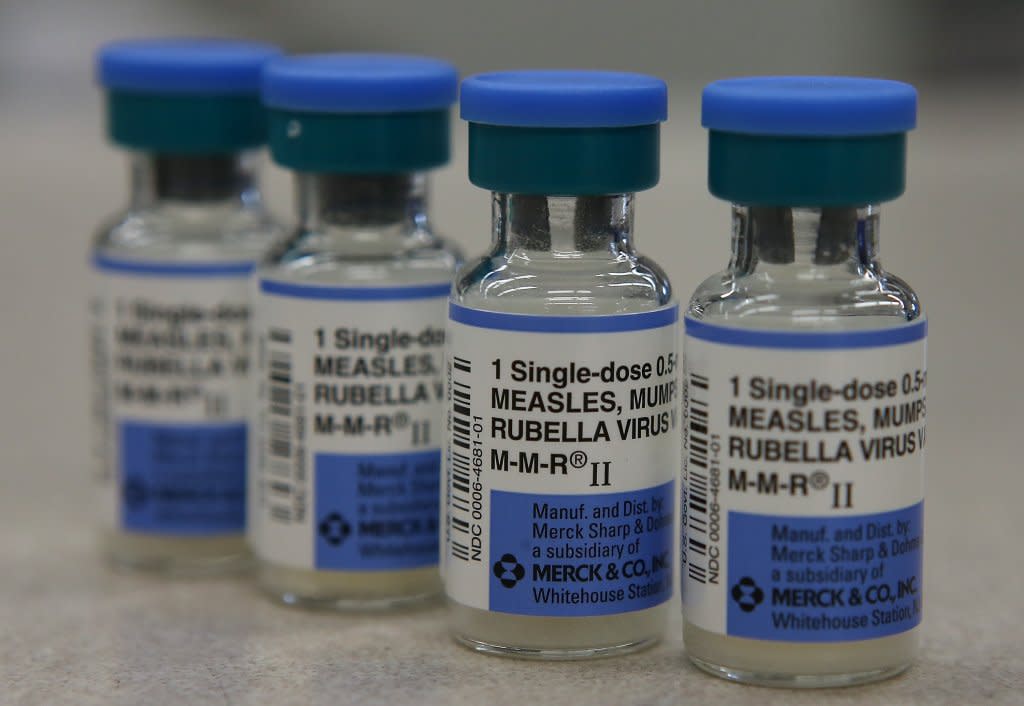Dane County measles case prompts state health department to alert the public

Vials of measles, mumps and rubella vaccine are displayed on a pharmacy counter. (Justin Sullivan | Getty Images)
A Dane County resident has a confirmed case of measles, the state health department reported Friday, the first reported case in Wisconsin since last fall.
Citing privacy concerns, the Department of Health Services (DHS) withheld demographic information about the person infected and whether the individual had been vaccinated, but reported that the individual had acquired the illness “while traveling domestically.”
There have been about 125 measles cases in 18 communities across the country so far this year, said Dr. Stephanie Schauer, Wisconsin immunization program manager, at a briefing for reporters.
“That’s quite a change from the previous year,” Schauer said, prompting DHS to call attention to the case. “We need to ensure that folks are protected against this disease.”
In the last decade, measles vaccination in Wisconsin has dropped by about six percentage points, from 88.2% of the population in 2013 to 81.6% in 2023, Schauer said.
“If measles is introduced into a community that really is too low to prevent the spread,” Schauer said. To prevent the virus from taking hold in a population requires a vaccination rate of more than 95%.
Vaccination rates also vary by county. With the decline in vaccination rates public health providers expect to see more outbreaks, Schauer said.
Health officials are monitoring to see whether other cases are reported, particularly among people exposed to the individual who has been identified with the disease.
The illness typically starts with a fever and can be accompanied at first by a cough or a runny nose. A rash typically develops about four days after the first symptoms appear, starting at the hairline and working its way down the body. Up to 30% of patients may develop diarrhea, an ear infection or other secondary complications. A typical patient is infectious for about nine days, and when the rash appears patients are likely to be infectious for another four days, Schauer said.
The illness is highly contagious, and people who begin to notice symptoms should “stay home if you’re feeling sick,” she said. It can take up to 21 days for a person who is exposed to show symptoms.
The measles, mumps and rubella (MMR) vaccine has been in use since 1963, and its widespread use has helped reduce the frequency of the illness since then. “These diseases aren’t gone, they’ve been held at bay,” Schauer said.
DHS is encouraging people who have not been vaccinated to get the vaccine. The recommended dose for children ages 6 months to 11 years old is one shot, and for ages 12 and up into adulthood, two doses. The vaccine is recommended for all, but particularly for people who are traveling outside the country.
DHS is recommending that people who haven’t been vaccinated or who aren’t sure about their vaccine status check with their health providers. People can also check with the Wisconsin Immunization Registry.
Schauer said it takes about two weeks for the full effect of the vaccine to take hold in a person. Even for someone who has had the shot for less time, it can help prevent some symptoms or reduce their severity, she added.
GET THE MORNING HEADLINES DELIVERED TO YOUR INBOX
The post Dane County measles case prompts state health department to alert the public appeared first on Wisconsin Examiner.

